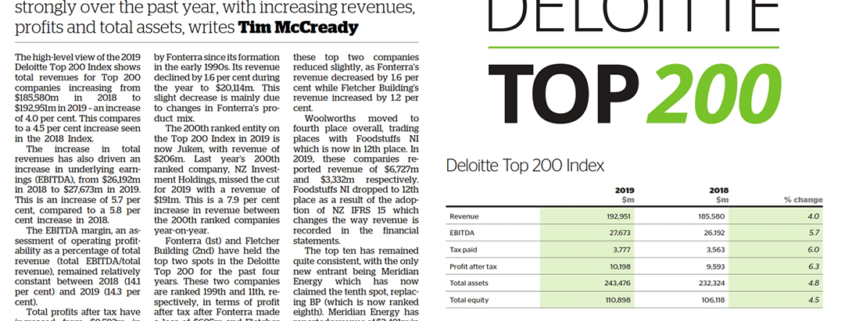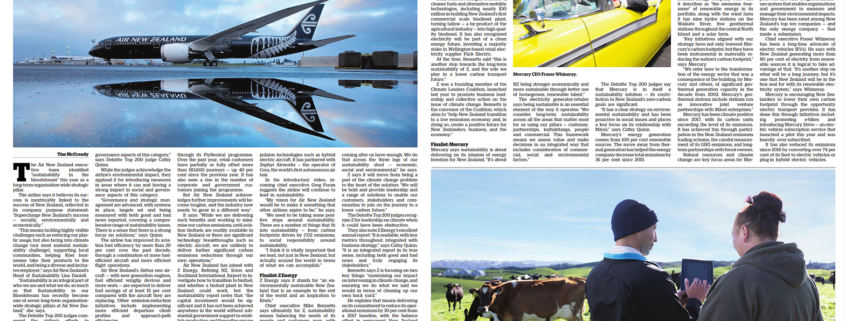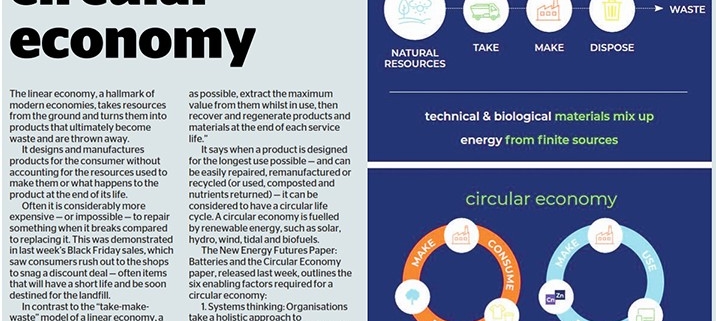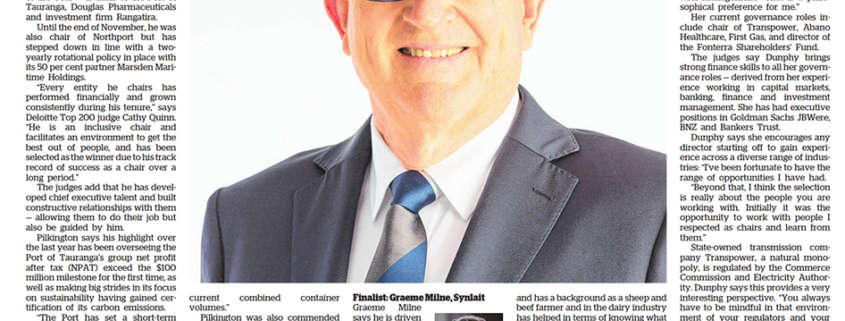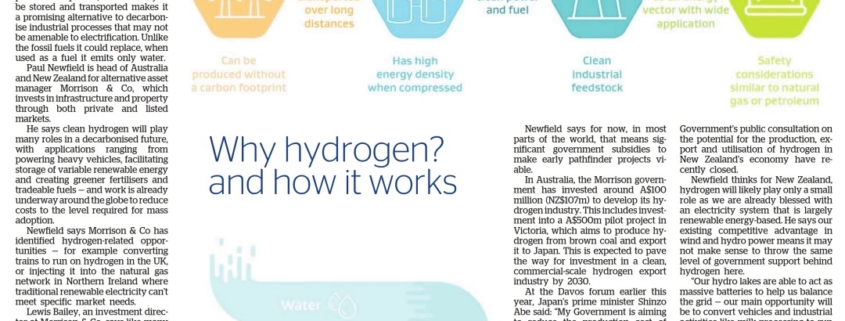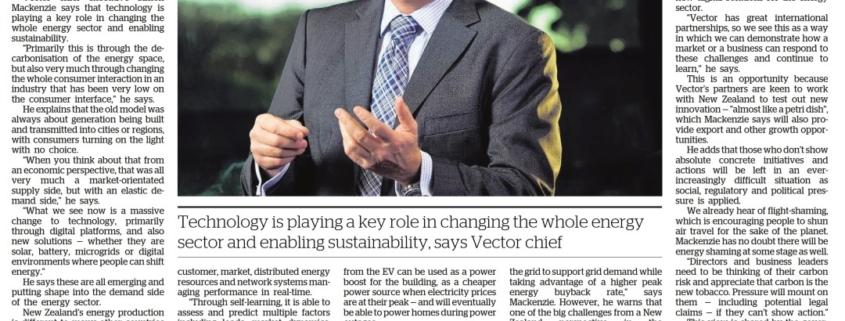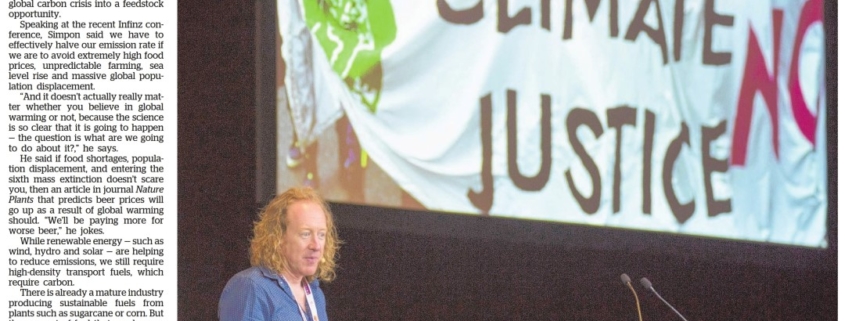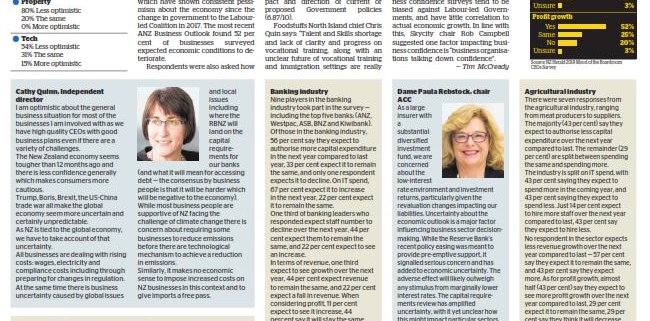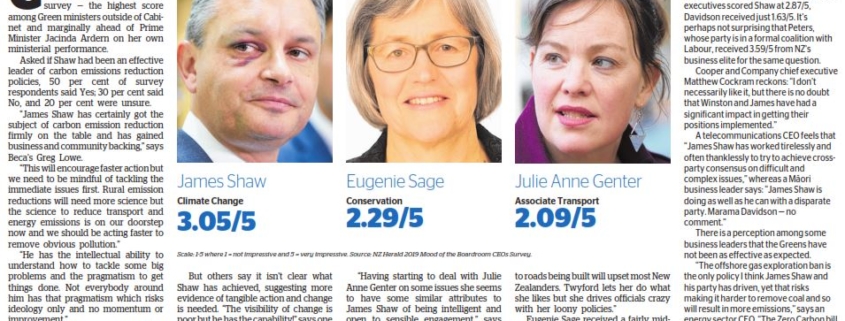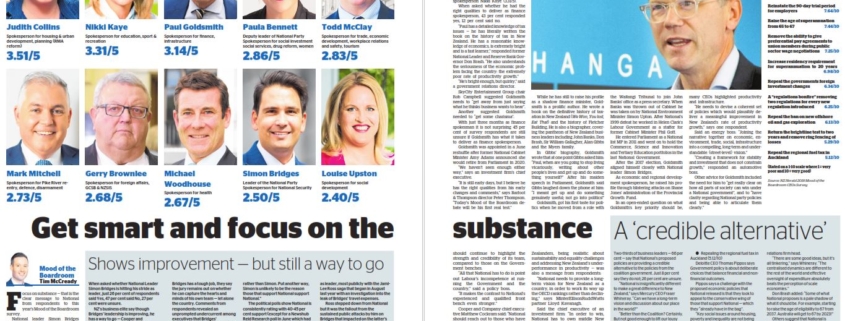The Air New Zealand executive team identified “sustainability in the bloodstream” this year as a long-term organisation-wide strategic pillar.
The airline says it believes its success is inextricably linked to the success of New Zealand, reflected in its company purpose statement: “Supercharge New Zealand’s success — socially, environmentally and economically.”
“This means tackling highly visible challenges such as reducing our plastic usage, but also facing into climate change (our most material sustainability challenge), supporting local communities, helping Kiwi businesses take their products to the world, and being a diverse and inclusive employer,” says Air New Zealand’s Head of Sustainability Lisa Daniell.
“Sustainability is an integral part of who we are and what we do, so much so that Sustainability in our Bloodstream has recently become one of seven long-term organisation-wide strategic pillars at Air New Zealand,” she says.
The Deloitte Top 200 judges commend the airline’s efforts in sustainability in an industry that contributes between two and four per cent of global emissions, and the transparency with which it reports on it through its sustainability report, released each year prominently alongside the more conventional financial reports.
The MinterEllisonRuddWatts Sustainable Business Leadership award is new to the Deloitte Top 200 Awards this year, recognising businesses that are working toward creation of long-term environmental, social and economic value.
The judging criteria considers governance, leadership and accountability, long-term perspective and purpose, explicit integration of environment, social and governance considerations, along with investments, programmes and projects to support sustainable development.
“Air New Zealand is showing strong leadership in diversity and inclusion as well as other social and governance aspects of this category,” says Deloitte Top 200 judge Cathy Quinn.
While the judges acknowledge the airline’s environmental impact, they applaud it for introducing measures in areas where it can and having a strong impact in social and governance aspects of this category.
“Governance and strategic management are advanced, with systems in place, targets set and being measured with both good and bad news reported, covering a comprehensive range of sustainability issues. There is a sense that there is a strong focus on solutions,” says Quinn.
The airline has improved its aviation fuel efficiency by more than 20 per cent over the past decade, through a combination of more fuel-efficient aircraft and more efficient flight operations.
Air New Zealand’s Airbus neo aircraft — with new generation engines, fuel efficient wingtip devices and more seats — are expected to deliver fuel savings of at least 15 per cent compared with the aircraft they are replacing. Other emission-reduction initiatives include implementing more efficient departure climb profiles and approach-path efficiencies.
Air New Zealand has moved to use electricity to power aircraft while at the gate whenever available, shifting away from consuming jet fuel and generating carbon dioxide emissions. It is also removing unnecessary weight from its domestic jet aircraft such as carrying less portable water on each flight and has removed or replaced nearly 55 million plastic items with lower-impact alternatives.
“The scale of our network and fleet means that any savings we make are substantial, and if we think about the influence we can have across our 4500 suppliers, or the likes of the Climate Leaders Coalition in New Zealand, that’s also really material,” says Daniell.
Air New Zealand’s sustainability report acknowledges that it emits around 3.5 million tonnes of carbon dioxide annually — making it one of New Zealand’s biggest carbon emitters.
The airline has been encouraging passengers to offset their emissions through its FlyNeutral programme. Over the past year, retail customers have partially or fully offset more than 183,600 journeys — up 40 per cent since the previous year. It has also seen a rise in the number of corporate and government customers joining the programme.
But Air New Zealand acknowledges further improvements will become tougher, and the industry now needs ‘to grow in a different way’.
It says: “While we are delivering such benefits and working to minimise our carbon emissions, until aviation biofuels are readily available in New Zealand or there are significant technology breakthroughs such as electric aircraft, we are unlikely to deliver further significant carbon emissions reductions through our own operations.”
Air New Zealand has joined with Z Energy, Refining NZ, Scion and Auckland International Airport to investigate how to transition to biofuel, and whether a biofuel plant in New Zealand could work, but the sustainability report notes that: “the capital investment would be significant and it has not been achieved anywhere in the world without substantial government support to establish production and thereafter ensure fuel pricing remains economically viable.”
It is also working with aircraft manufacturers to explore new propulsion technologies such as hybrid electric aircraft. It has partnered with Zephyr Airworks — the operator of Cora, the world’s first autonomous air taxi.
In his introductory video, incoming chief executive Greg Foran suggests the airline will continue to lead in sustainability.
“My vision for Air New Zealand would be to make it something that other airlines aspire to be,” he says.
“We need to be taking some positive steps around sustainability. There are a number of things that fit into sustainability — from carbon footprints driven by CO2 emissions, to social responsibility around sustainability.
“I think it is vitally important that we lead, not just in New Zealand, but actually around the world in terms of what we can accomplish.”
Finalist: Z Energy
Z Energy says it stands for “an environmentally sustainable New Zealand that is an example to the rest of the world and an inspiration to Kiwis.”
Chief executive Mike Bennetts says ultimately for Z, sustainability means balancing the needs of its people and customers now, with those of its people and customers of tomorrow.
“It means not taking more than we need now, so that those generations coming after us have enough. We do that across the three legs of our sustainability stool — economic, social and environmental,” he says.
Z says it will move from being a part of the climate change problem to the heart of the solution: “We will be bold and provide leadership and a range of solutions to enable our customers, stakeholders and communities to join on the journey to a lower carbon future.”
The Deloitte Top 200 judges recognise Z for leadership on climate when it could have been obstructive.
They also note Z Energy’s excellent annual report: “It is readable, with key metrics throughout, integrated with business strategy,” says Cathy Quinn. “It is an integrated report in its true sense, including both good and bad news and truly engaging its stakeholders.”
Bennetts says Z is focusing on two key things: “maximising our impact on intervening in climate change, and ensuring we do what we said we would in terms of cleaning up our own back yard.”
He explains that means delivering on its commitment to reduce its operational emissions by 30 per cent from a 2017 baseline, with the balance offset in permanent New Zealand forestry — a mix of natives and exotics.
“We have the opportunity to be right at the centre of the transport fuels solution but that will mean nothing if our responses lack integrity,” he says. “We are up for the difficult conversations on how we intervene in climate change that provides harmony across environmental, social and economic sustainability.”
Bennetts acknowledges the company’s big issue is the products it sells, not what it does. But he says that is exactly why Z can have the biggest impact.
“Our intent is to lead and facilitate the much-needed transition to lower carbon transport fuels than default to being a barrier to change,” he says. “The technology exists for lower carbon alternatives like biofuel and hydrogen, but our current challenge is finding a way to make that economically sustainable for our customers given the environmental and social Sustainability in the bloodstream sustainability is obvious enough.”
Bennetts says capital and innovation will come easily when the economics are better balanced, “especially when we price in the reality of social and environmental externalities.”
Z has been investing in alternative, cleaner fuels and alternative mobility technologies, including nearly $30 million in building New Zealand’s first commercial scale biodiesel plant, turning tallow — a by-product of the agricultural industry — into high quality biodiesel. It has also recognised electricity will be part of a clean energy future, investing a majority stake in Wellington-based retail electricity supplier Flick Electric.
At the time, Bennetts said “this is another step towards the long-term sustainability of Z, and the role we play in a lower carbon transport future.”
Z was a founding member of the Climate Leaders Coalition, launched last year to promote business leadership and collective action on the issue of climate change. Bennetts is the convenor of the Coalition, which aims to “help New Zealand transition to a low emissions economy and, in doing so, create a positive future for New Zealanders, business, and the economy.”
Finalist: Mercury
Mercury says sustainability is about delivering on its mission of energy freedom for New Zealand. “It’s about NZ being stronger economically and more sustainable through better use of homegrown, renewable talent.”
The electricity generator-retailer says being sustainable is an essential element of the way it operates: “We consider long-term sustainability across all the areas that matter most for us using our pillars — customer, partnerships, kaitiakitanga, people and commercial. This framework means we assess value and make decisions in an integrated way that includes consideration of commercial, social and environmental factors.”
The Deloitte Top 200 judges say that Mercury is in itself a sustainability solution — its contribution to New Zealand’s zero-carbon goals are significant.
“It has a clear strategy on environmental sustainability and has been proactive in social issues and places a key focus on its relationship with Māori,” says Cathy Quinn.
Mercury’s energy generation comes from 100 per cent renewable sources. The move away from thermal generation has helped the energy company decrease total emissions by 36 per cent since 2015.
This year, it committed to the construction of a new $256m wind farm at Turitea, east of Palmerston North — and recently announced it will pour another $208m to complete the farm at its full scale.
This makes Mercury the only New Zealand energy company with what it describes as “the awesome foursome” of renewable energy in its portfolio; along with the wind farm it has nine hydro stations on the Waikato River, five geothermal stations throughout the central North Island and a solar farm.
“Key initiatives aligned with our strategy have not only lowered Mercury’s carbon footprint, but they have been instrumental in materially reducing the nation’s carbon footprint,” says Mercury.
“We refer here to the transformation of the energy sector that was a consequence of the building, by Mercury and others, of significant geothermal generation capacity in the decade from 2003. Mercury’s geothermal stations include stations run as innovative joint venture partnerships with Māori enterprises.”
Mercury has been climate positive since 2017, with its carbon units exceeding the level of its emissions. It has achieved this through participation in the New Zealand emissions trading scheme, the careful measurement of its GHG emissions, and long-term partnerships with forest owners.
Natural resources and climate change are key focus areas for Mercury, it aspires to be recognised as a leader in the ultra-long-term management of both physical and natural assets by 2030.
For the last two years, Mercury has submitted information to the CDP (formerly the carbon disclosure project). The CDP runs the global disclosure system that enables organisations and government to measure and manage their environmental impacts. Mercury has been rated among New Zealand’s top ten companies — and the only energy company — that made a submission.
Chief executive Fraser Whineray has been a long-time advocate of electric vehicles (EVs). He says with New Zealand generating more than 80 per cent of electrity from renewable sources it is logical to take advantage of that. “It’s another step on what will be a long journey, but it’s one that New Zealand will be in the box seat for with its renewable electricity system,” says Whineray.
Mercury is encouraging New Zealanders to lower their own carbon footprint through the opportunity electric transport provides. It has done this through initiatives including promoting e-bikes and introducing Mercury Drive — an electric vehicle subscription service that launched a pilot this year and was heavily over-subscribed.
It has also reduced its emissions since 2016 by converting over 74 per cent of its fleet to electric vehicles or plug-in hybrid electric vehicles.

